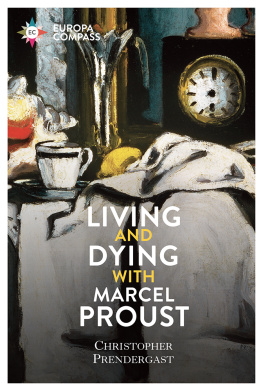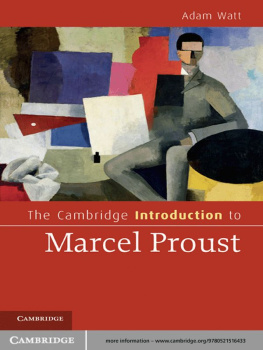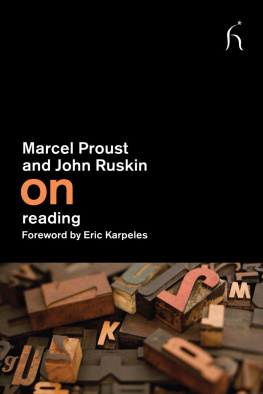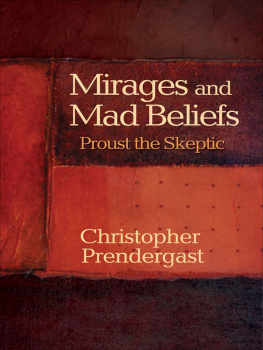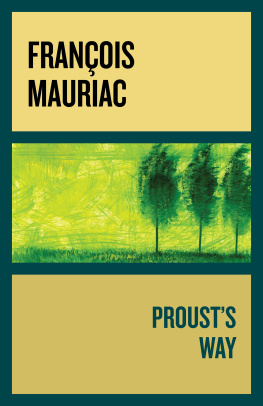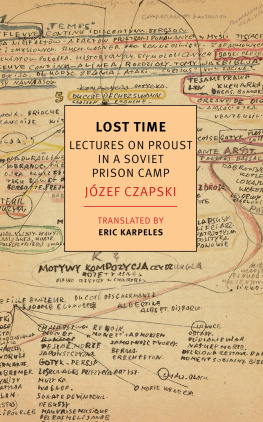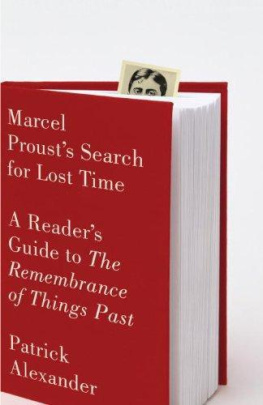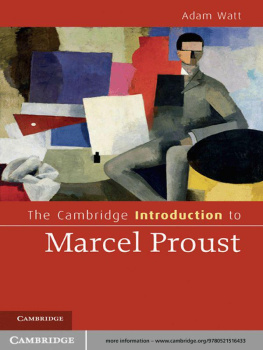ALSO BY
C HRISTOPHER P RENDERGAST
In Search of Lost Time
(general editor of the Penguin translation)
Mirages and Mad Beliefs: Proust the Skeptic
A History of Modern French Literature, 1500-2000
(editor and contributor)
LIVING AND DYING
WITH MARCEL PROUST
P REFACE
T he origins of this book are the remnants of a previous one, a heap of unused jottings and scribbles set aside with no clear notion of what might become of them beyond the vague idea of a further venture that would begin with an excursus on the theme of walks in la recherche du temps perdu: the childhood walks on the Msglise and the Guermantes Ways; the outings to the Champs-Elyses and the Bois de Boulogne; the strolls along the promenade of the seaside resort, Balbec; the nocturnal zigzags through the back streets of Venice; the Tansonville walks with Gilberte; the wanderings through the streets and boulevards of wartime Paris. Hovering in the background was some undeveloped notion of comparing and contrasting the Proustian walks with others in fiction (for example, those of Jane Austens world). Unsurprisingly, it did not take long for this idea to bite the dust, though traces of the walks remain, and Jane Austen makes a brief appearance in connection with the theme of rooms and doors.
Some of the random detritus made it promptly to the wastepaper basket (what, frankly, was one supposed to do with Proust at his aphoristic worst inviting us to take seriously the claim that the nose is the facial seat of stupidity?). Most remained in the drawer, assumed to be extinct before coming up against a version of the question raised by Prousts narrator in respect of his lost past just before he tastes the celebrated madeleine: dead forever?the negative answer to which is the resurrection which makes possible Prousts novel itself.
The eventual fate of my notes had nothing to do with any quasi-mystical relation to the consumption of pastries in what finally emerged: a suite of explorations on an arc defined by the Living and Dying of my title, in turn shaped by those aspects of his novel which have seemed to me to embody and reflect most distinctively its engagement with these two all-embracing primordial polarities. Since the latter can naturally be taken to signify nothing short of everything, it is important to stress that the explorations are based on a set of selections (for example, where in the chapter on colour I have foregrounded pink, others might substitute, say, blue or yellow). Furthermore, the book is not organized as a through-argument defending a particular thesis. The individual chapters are on the whole left to speak for themselves around the principal topic each individually addresses. At the same time and more broadly, the book unfolds on three major axes, initially as an extended account of the rich sensory world of bodily life, before turning to more formal matters centred on Prousts way with the structural properties of the art of fiction, and from there gravitating to the preordained realms of ending and extinction.
Although it is my hope that the book will be of interest to the specialists, it is not specifically intended for an academic audience and is accordingly bereft of the standard apparatus of scholarly referencing, which, among other things, would give an indication of my own substantial debts to the vast corpus of Proust scholarship. There are occasional footnotes, but for the most part they serve a purpose of internal cross-referencing as a means of linking chapters, a demonstration in a minor key of the vast network of echoes, loops and associations that constitutes the fabric of Prousts text. Beyond the mountain of the here unacknowledgeable, there gladly remain the personal acknowledgments of friends and colleagues for whose assistance and encouragement I am deeply grateful:
Vronique Aubouy; Hugo Azerad; Alessandra Cavalli; Stanley Corngold; Emily Eeells; Irne Fabry-Tehranchi; Margaret Gray; Jane Haynes; Nathalie Mauriac Dyer; Eric Mchoulan; Marion Schmid; Julie Thomas; Rhiannon Williams; Michael Wood. Special thanks go to my editor Christopher Potter, for his faith in the book along with his hawk-eyed editing of the draft, and to my copy editor, Sarah Ream whose eagle-eyed scrutiny led to many a graceful swoop on parts of my text in need of correction. Last, but not ever least, my thanks to Bridget Strevens Marzo, in particular for her observation that the Contents page reads like a surrealist poem. (I have yet to figure out whether this was meant as a compliment.)
A note on editions and translations: For the original French I have used the splendid 1987 Pliade edition. Translation is a more delicate issue, because of the required declaration of interest in my having chosen to use the 2002 Penguin translation, of which I was the general editor but to which here I have taken the liberty of making occasional changes.
1
T HE P ROUST E FFECT
I
I begin with a question I would never have imagined myself asking, let alone attempting to answer. Is Proust good for you? Might he even, if in carefully controlled doses, have a useful functionas neuroscientists have claimedin the regimens of modern healthcare? He certainly belongs in the select, if occasionally scary, company of writers whose name, or that of one of their fictional characters, has lent itself to the designation of a psychophysical condition, often with medical characteristics. A short list includes Stendhal (Stendhal syndrome, the condition of obsessional attachment to works of art); Musset (de Musset sign, an uncontrollable tremor of the head); Gogols Plyushkin in Dead Souls and Dickenss Miss Havisham in Great Expectations (Plyushkin syndrome and Havisham syndrome, alternative names for compulsive hoarding or senile squalor syndrome); Wildes Lady Windermere (Lady Windermere syndrome, pulmonary disease in frail, usually elderly, women). Alongside these impressively vivid specifications, the appropriation of Proust to the naming game will seem tamely laconic. The Proust effect refers to the writers exploration of the forms and processes of sensory memory, most notably those that involve the phenomenon of synaesthetic perception (of which much more anon, though entirely severed from the medical domain). Claimed by a branch of neuroscience (Proust Was a Neuroscientist runs the title of one study), the effect is held to be of both diagnostic and therapeutic use in connection with memory loss and cognitive confusion. The claim is further buttressed by a truly remarkable speculation, to the effect that medical science would have benefitted hugely if after his death Prousts hippocampus had been preserved for the purposes of research.
This is just the first of several Proust-centred counterfactuals that we shall encounter in the course of this book (one of them absolutely stunning), but its assertions on behalf of the might-have-been posthumous life of the Proustian cerebellum qualify it as probably the most exotic. On the other hand, it is not that surprising to find Proust among the neuroscientists, if only for the reason that it was very much where he was to be found, directly or indirectly, in the course of his own life. With a physician father who also distinguished himself in several branches of research including the developing specialism of neurology, Proust was raised in a milieu where, as his epic biographer, Jean-Yves Tadi, tells us, at times he seems to know most of the neurologists in Paris. He also acquired an extensive if somewhat inexpert knowledge of ailments and treatments, especially his own in respect of the former and especially drugs in connection with the latter. This did not always end well. Two outstanding mishaps among several were the self-administered overdose of veronal (for insomnia) which, as the result of a labelling confusion, led Proust to read the number 0.7 as 7

